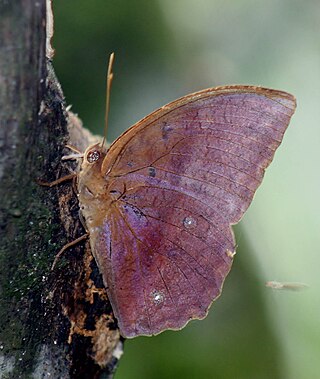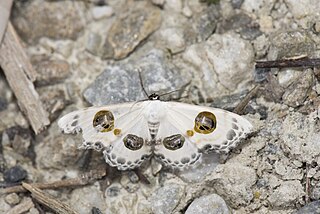
Discophora sondaica, the common duffer, is a species of nymphalid butterfly found in Southeast Asia.

Discophora timora, the great duffer, is a butterfly found in South Asia that belongs to the Morphinae subfamily of the brush-footed butterflies family.

Passiflora discophora is a species of plant In the family Passifloraceae, native to western Ecuador and Colombia. It is restricted to closed wet coastal forest, and considered endangered due to the rapid ongoing deforestation of Ecuador's coast.

Amathusiini is a tribe of the nymphalid butterfly subfamily Morphinae. They are large butterflies. They are sometimes treated as a distinct subfamily Amathusiinae or family Amathusiidae.

Passiflora arbelaezii is a species in the family Passifloraceae native to eastern Nicaragua and western Colombia. This species was named in honor of Enrique Pérez Arbeláez, the person who collected the type specimen. It was first formally described in 1957 by Antonio Lorenzo Uribe Uribe. Like Passiflora discophora and Passiflora tryphostemmatoides this species is rather unusual within its genus, due to the specialised adhesive structures. Passiflora arbelaezii forms branched tendrils with terminal adhesive pads, which form after contact of the distal ends with the substrate. Proliferation of papillate cells ensures close adhesion to the surfaces, which are mirrored in their microtopology by the proliferating cells, in addition to adhesive secretions of the structures.
Cymindis discophora is a species of ground beetle in the subfamily Harpalinae. It was described by Maximilien Chaudoir in 1873.

Discophora, commonly known as the duffers, is a genus of butterflies in the family Nymphalidae. The members are confined to India, China and Southeast Asia.

Problepsis discophora is a moth of the family Geometridae. It is found in Korea, Taiwan and the Russian Far East.
Leptothrix ochracea is a bacterium from the genus Leptothrix. It occurs in iron-rich fresh water and wetlands with only low concentrations of organic matter.
Leptothrix lopholea is a bacterium from the genus Leptothrix.
Leptothrix cholodnii is a bacterium from the genus Leptothrix, which has the ability to oxidize Fe(II).. They were previously known as Leptothrix discophora SP-6. They are fast-growing metal oxidizers in iron-rich environments. These environments include freshwater bodies characterized with neutral to slightly acidic pH, oxygen gradients and organic matter. Examples of these sites include freshwater streams and wetlands, iron seeps, water pipes, surface of sediments Their growth under suitable conditions is easily recognized with fluffy microbial mats, surface biofilms made up of oxidized Fe and Mn minerals with orange to dark brown color. They can oxidize both Fe(II) and Mn(II). Leptothrix cholodnii SP-6 is a member of this group with an isolate and sheath-former under laboratory conditions.
Leptothrix mobilis is a bacterium from the genus Leptothrix which was isolated from freshwater sediments.

Stemonuraceae is a eudicot family of flowering plants.

Discophora is a genus of trees in the family Stemonuraceae. There are two species, Discophora guianensis and Discophora montana. The plants occur in the Neotropics.
Discophora is a scientific name for several groups of organisms:
Catephia discophora is a species of moth of the family Erebidae. It is found in South Africa.
Leptothrix is a monotypic genus of dwarf spiders containing the single species, Leptothrix hardyi. It was first described by Anton Menge in 1869.









